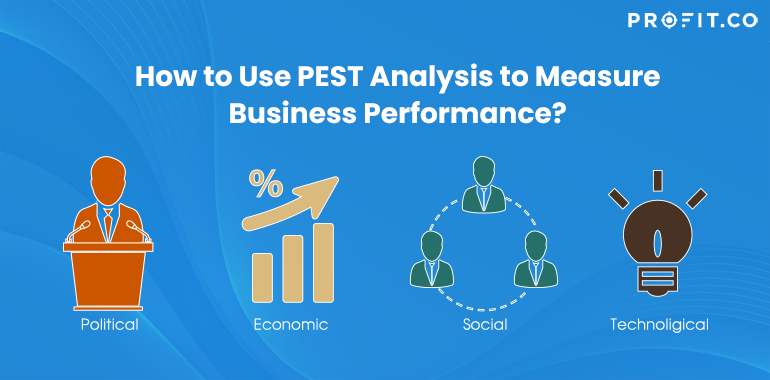This blog is your gateway to mastering PEST analysis and transforming those insights into actionable, measurable business strategies. Let’s embark on this journey to elevate your business strategy to new heights with formulas and real life examples.
What is a PEST analysis?
PEST analysis is a valuable research framework for examining how external factors — political, economic, socio-cultural, and technological — can impact your business. This tool provides a comprehensive view of the macro-environmental influences surrounding your organization. In some instances, the acronym extends to PESTLE, further incorporating legal and environmental considerations alongside the core four elements, offering an even more thorough analysis of your business’s external landscape.
“For one thing, there’s an essential human factor in every business endeavor. It doesn’t matter if you have a perfect product, production plan and marketing pitch; you’ll still need the right people to lead and implement those plans.”
PEST Analysis is crucial for businesses for several key reasons:
Strategic Insight: It helps you understand the current and future external influences on your business, so you can work with facts rather than assumptions.
Opportunity Identification: It helps you identify opportunities and threats and plan your strategy accordingly.
Risk Management: It plays a significant role in risk management by highlighting external threats and challenges.
Market Understanding: It helps you adapt to the changing business environment and remain competitive.
Adaptability and Agility: It helps you evaluate the feasibility and profitability of a new product or market
Overall, PEST Analysis is an indispensable tool for businesses, providing essential insights for strategic planning, opportunity identification, risk management, market analysis, and ensuring adaptability in a dynamic business environment.
Need tailored advice on implementing PEST Analysis in your business?
Identifying PEST Analysis KPIs
In strategic planning and market analysis, PEST Analysis is a fundamental tool that helps organizations navigate their external macro-environment. The first step in using PEST analysis to measure your business performance is to identify the most important external factors that affect your business. Conducting PEST analysis involves scanning the political, economic, social, and technological environment of your industry and market.
Political KPIs
Political Key Performance Indicators (KPIs) serve as essential metrics for businesses navigating the often complex and dynamic landscape of government policies and political environments. These KPIs are instrumental in evaluating how well a company adapts to and complies with legislative changes, as well as in assessing the potential impact of political risks on its operations. By monitoring these indicators, businesses can make more informed decisions, mitigate risks, and ensure regulatory compliance, which is crucial for maintaining a strong market position and reputation. Two primary Political KPIs often utilized are the Legislation Compliance Rate and the Political Risk Score.
- Legislation Compliance Rate
This KPI measures the extent to which different departments within a company adhere to relevant legislative requirements.
Formula: (Number of Compliant Departments / Total Departments) * 100
Example: If a company has 10 departments, and 9 are fully compliant with new privacy regulations, the Legislation Compliance Rate is (9/10) * 100 = 90%. - Political Risk Score
This KPI quantifies the level of political risk a company might face in its operations.
Formula: Assign values to political risks, sum them, and divide by the number of assessed factors.
Example: Considering three political risks valued at 2, 4, and 3, the Political Risk Score is (2+4+3) / 3 = 3.
Economic KPIs
Economic Key Performance Indicators (KPIs) are critical metrics for assessing how a company’s performance aligns with or is influenced by the broader economic environment. These KPIs offer valuable insights into the financial health and operational efficiency of a business about economic conditions and trends. Understanding and monitoring these indicators can help businesses make strategic decisions, forecast future growth, and manage financial risks more effectively. Two significant Economic KPIs commonly used are the Economic Growth Alignment and the Interest Impact Ratio.
- Economic Growth Alignment
This metric compares a company’s revenue growth rate with the national Gross Domestic Product (GDP) growth rate.
Formula: (Company Revenue Growth Rate / National GDP Growth Rate) * 100
Example: If the national GDP growth rate is 2% and the company’s revenue growth rate is 8%, the Economic Growth Alignment is (8/2) * 100 = 400%. - Interest Impact Ratio
This focuses on the company’s financial management, particularly how it handles its debt.
Formula: (Interest Expense / Earnings Before Interest and Tax) * 100
Example: With an EBIT of $500,000 and an interest expense of $50,000, the Interest Impact Ratio is ($50,000 / $500,000) * 100 = 10%.
Social KPIs
Social Key Performance Indicators (KPIs) are essential for businesses to evaluate their performance and strategy in the context of societal trends and public sentiment. These indicators provide insights into how well a company is aligned with its target market and how effectively it engages with its audience. Understanding and monitoring Social KPIs can help businesses to enhance their brand image, adapt to demographic shifts, and improve their engagement strategies. Two important Social KPIs are the Market Demographics Match and the Brand Engagement Score.
- Brand Engagement Score
The Brand Engagement Score measures the level of interaction and engagement that a company’s brand generates, particularly in digital and social media platforms
Formula: (Number of Engagement Actions / Total Audience) * 100
Example: If your brand’s social media posts receive 1,000 engagement actions from a total audience of 10,000, the Brand Engagement Score is (1,000 / 10,000) * 100 = 10%. - Market Demographics Match
This KPI assesses how well a company’s target market segment aligns with the overall market size.
Formula: (Target Market Segment Size / Total Market Size) * 100
Example: If your target market segment is 50,000 in a total market of 200,000, the Market Demographics Match is (50,000 / 200,000) * 100 = 25%.
Technological KPIs
Technological Key Performance Indicators (KPIs) are critical metrics for companies to assess the impact of technological advancements on their operations and innovation. In an era where technology evolves rapidly, these KPIs help businesses understand how effectively they are integrating new technologies and fostering innovation to stay competitive. Monitoring technological KPIs is essential for businesses to ensure they are leveraging technology efficiently and are at the forefront of innovation in their industry. Two primary Technological KPIs are the Technology Utilization Rate and the Innovation Index.
- Technology Utilization Rate
This KPI measures the extent to which a company has incorporated technology into its operations.
Formula: (Number of Processes Automated / Total Number of Processes) * 100
Example: If 150 out of 200 processes are automated, the Technology Utilization Rate is (150/200) * 100 = 75%. - Innovation Index
The Innovation Index quantifies a company’s focus on developing new products or services.
Formula: (Number of New Products Developed / Total Products) * 100
Example: If a company has a total of 50 products and 10 were developed in the last year, the Innovation Index is (10/50) * 100 = 20%.
These KPIs provide quantifiable metrics to gauge the impact of each PEST factor on your organization and help in aligning your strategic response effectively.
Integrating OKRs and PEST Analysis
Integrating Objectives and Key Results (OKRs) with PEST Analysis is a strategic approach to align an organization’s internal goal-setting with external environmental factors.
While PEST focuses on macroeconomics, OKRs can be a framework to drive microeconomics for an organization by using the plan of outcome from PEST analysis and combining it with the plan of action to drive these initiatives.
Here’s how you might structure OKRs based on insights gained from a PEST analysis, along with corresponding initiatives to achieve them:
Political OKR:
Objective: Enhance compliance with emerging international trade regulations.
KR 1: Increase the trade compliance rate from 75% to 95% within the next fiscal year
- Implement comprehensive training programs for staff focusing on international trade regulations.
- Deploy advanced compliance software solutions that automatically update with changing regulations and assist in ensuring trade activities are compliant.
- Schedule quarterly internal and external audits to assess and ensure adherence to trade regulations, identifying areas of non-compliance and taking corrective actions.
KR 2: Reduce the number of compliance-related issues from 10 to 2
Initiatives:
- Conduct thorough investigations into current compliance-related issues to understand underlying causes and prevent recurrence.
- Establish a robust system for reporting potential compliance issues. This should include anonymous reporting channels and a fast response team.
- Regularly engage with regulatory bodies to gain insights into compliance expectations and receive guidance on complex issues.
KR 3: Expand the coverage of compliance monitoring systems from 50% to 90%
Initiatives:
- Invest in state-of-the-art monitoring technologies that can provide broader and more efficient coverage of trade activities.
- Ensure that compliance monitoring systems are integrated across various departments and trade functions for comprehensive oversight.
- Establish a system for continuous monitoring with real-time alerts and a feedback loop for immediate rectification of any identified issues.
Final Thought
By now you would have realized, that utilizing PEST Analysis as a tool for measuring business performance is an insightful and strategic approach. It allows businesses to thoroughly examine external factors – Political, Economic, Social, and Technological – that can impact their operations and growth. By understanding and adapting to these external influences, companies can make more informed decisions, anticipate future trends, and create strategies that are both responsive and forward-thinking. Implementing PEST Analysis not only helps in identifying potential threats and opportunities but also aids in maintaining a competitive edge in an ever-changing business landscape. Ultimately, PEST Analysis is an essential component for businesses aiming for long-term success and sustainability.

